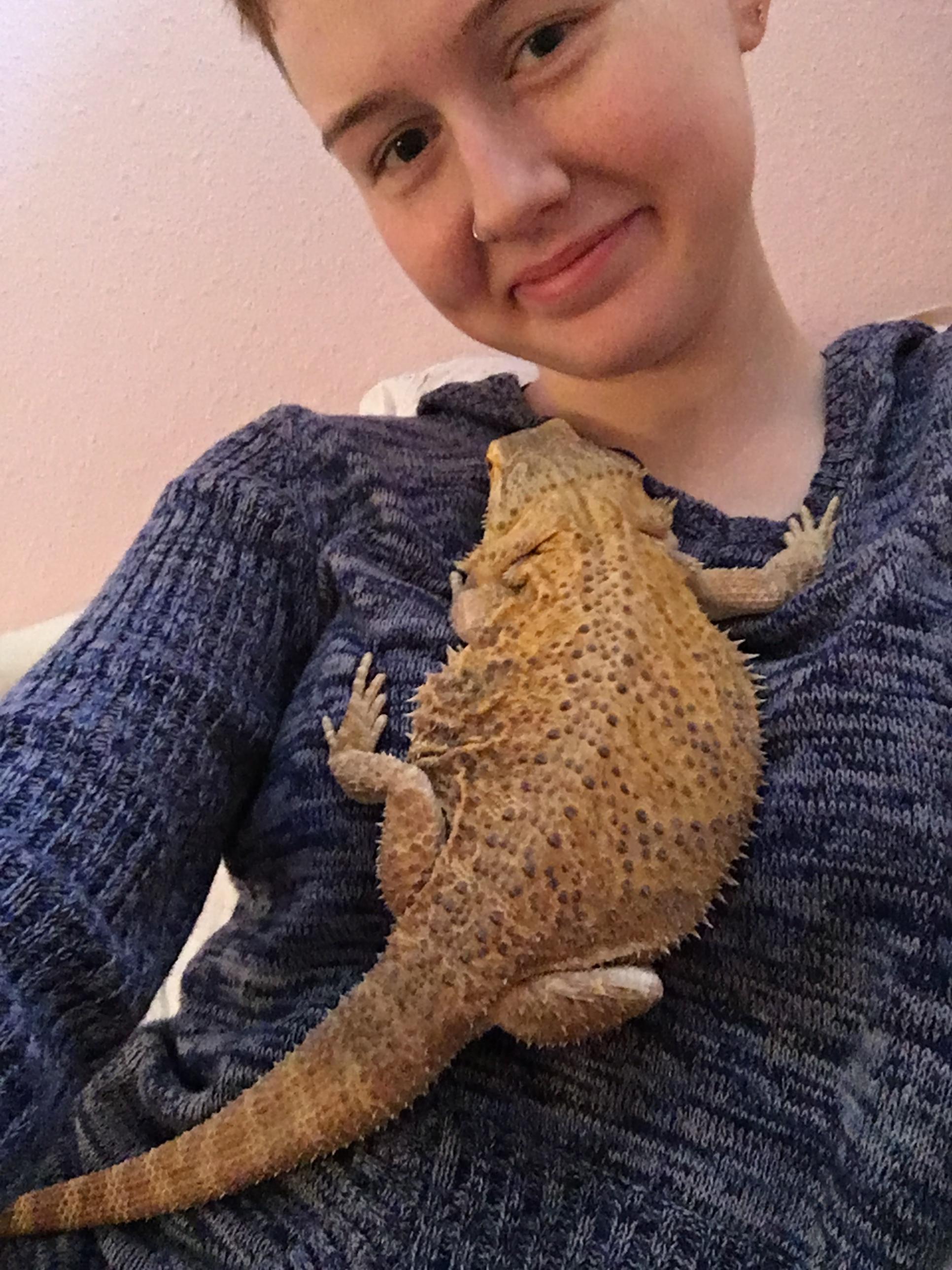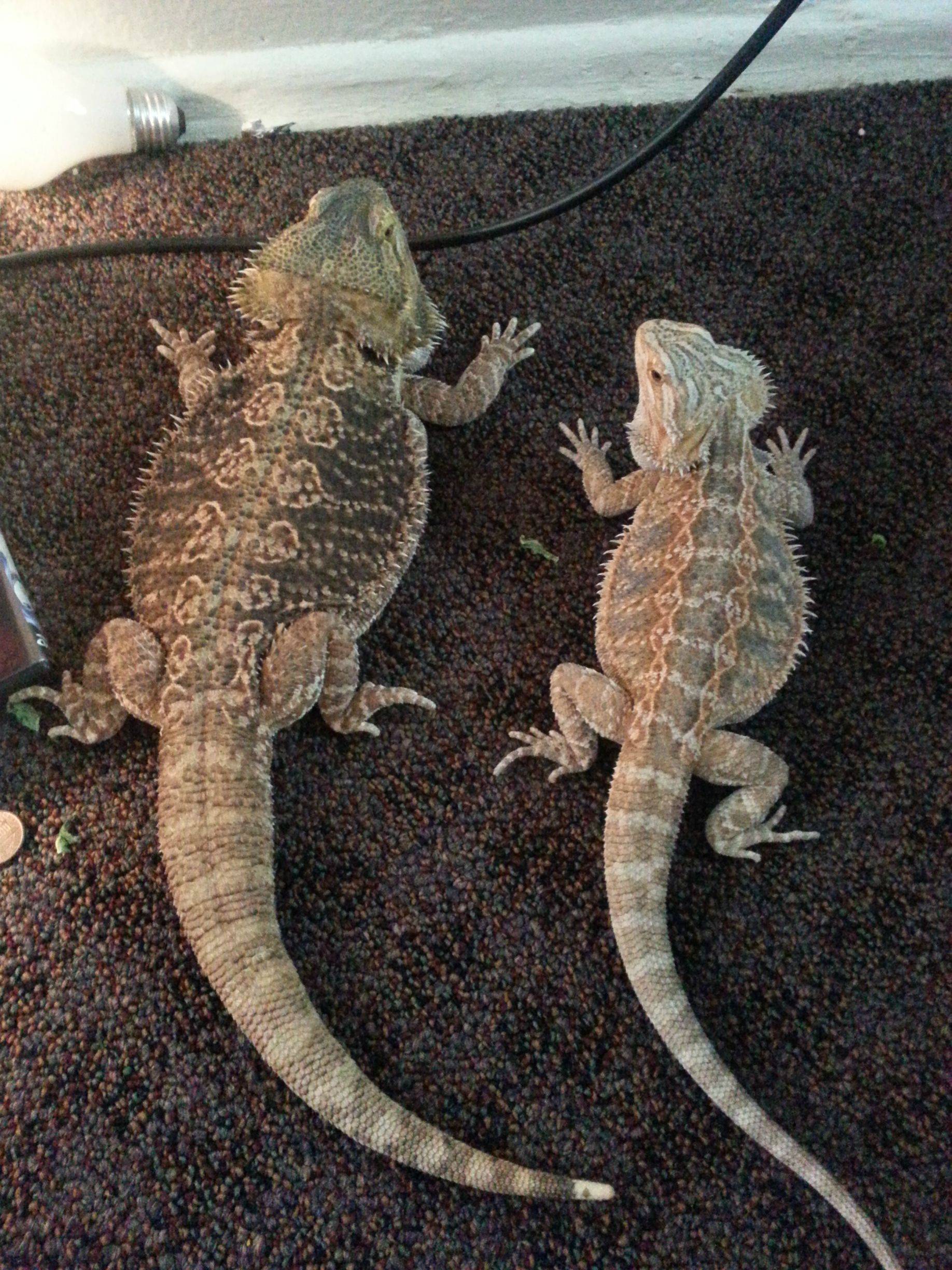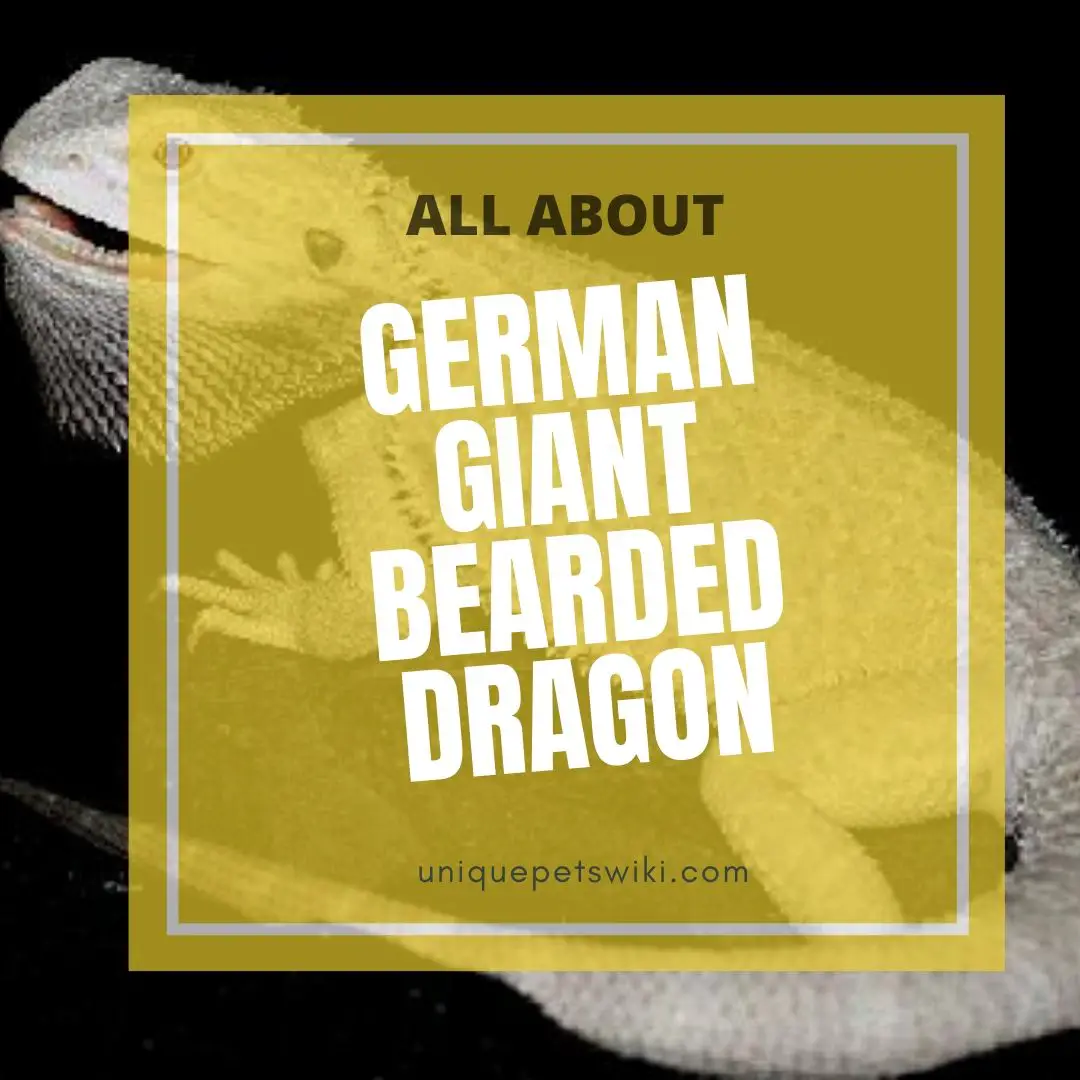German giant bearded dragons are unique bearded dragon pets. They can grow up to be way larger than the typical bearded dragons.
The same as bearded dragons in general, they usually are docile, easy to care and come in a variety of different and gorgeous colors.
In this article, we explore the giant bearded dragon species and how to know if you have a German giant bearded dragon.
By the end of the article, you will know what precisely a German giant is and everything that concerns them.
This article has been reviewed by Dr. Dilber. Read more about our knowledge control process here.
Contents
What is a German Giant Bearded Dragon?
What is a German giant bearded dragon?
You might hear about designed morph in geckos. German giant bearded dragon, in the same way, breeders create those species by breeding the large bearded dragons.
When you breed large species together, there is a better chance to create larger species (even larger than their parent). Then, it’s called a “giant”.
To learn more about this beautiful breed, keep reading along.
How to Know if You have a German Giant Bearded Dragon?

The German giant bearded dragon is the largest type of bearded dragon, growing to be more than 26 inches long and weighing more than 2 pounds. They are not the same as the regular bearded dragon species but rather a type of bearded dragon bred to be larger.
To tell if a bearded dragon is a German giant type, you can look for some clues such as:
- The size and weight of the dragon. A German giant bearded dragon should be significantly larger than a normal bearded dragon of the same age and sex.
- The color and pattern of the dragon. A German giant bearded dragon can have different colors and patterns, but the most common type is the Normal type, which is typically brown or olive in color with some dark spots or stripes running down its back. The Red type is characterized by its red coloring and lack of patterns or markings on its body.
- The origin and history of the dragon. A German giant bearded dragon should have a documented lineage that traces back to the original breeders in Germany who selectively bred large bearded dragons. However, German giant bearded dragons are no longer available, and most sold today are just large normal bearded dragons or hybrids. So, if you were introduced to a “giant” species, do not trust that except once they have certificates.
New to the bearded dragon? Check out the bearded dragon care sheet now! We listed everything you need to know about bearded dragons as pets.
It is quite challenging to tell if you have a German giant, especially when you have no idea about them. But the following features can help you identify if you have one.
| German Giant Bearded Dragon | Normal Bearded Dragon | |
| Baby size (hatch – 6 months) | 3 to 21 inches | 3 to 14 inches |
| Adult size (7 – 24 months) | 25 to 35 inches | 16 to 24 inches |
| Food | Insects, veggies | Insects, veggies |
| Lifespan | 850-1000 grams | around 400 to 500 grams |
| Availability & Price | No | Yes, from $20 to $1000 |
Adult German Giant Length
You may want to check the length of your beardie when it is fully grown. An adult German giant can grow up to 26 inches; some will reach 35 inches long. These dragons get much larger than the standard ones, whose average length is 16 to 24 inches.
It is not possible to identify a young German giant; you have to wait until when fully grown to find out.
Weight of the Dragon
Weight is another parameter that can help you identify a German giant dragon. But it is only valid when the dragon is fully grown.
A healthy and mature German giant can weigh up to 1000 grams, making them much bigger than the average standard dragon.
However, sometimes weight may not give reliable findings because it can vary among the dragons depending on health, diet, etc.
Parents Genes
Another way to guide you in figuring out whether you have a German giant bearded dragon is by looking at its parents. Having bought your beardie from the breeders, the majority of them tend to keep records, and they can trace back to the parents.
But in case you got your beardie from a pet store, it might be challenging to get any past information about the beardie. However, the parents may only be the carriers of the recessive gene, making it unlikely to get the answer.
Blood Test
Before you choose to use this method, bear in mind that it will cost you money and time due to routine visits to the vet.
Some the exotic veterinarians can confidently conduct a blood test and check the genes to look for the morphs of the bearded dragons. It is still a good option if you are curious to know whether you have a German giant.
German Giant Bearded Dragon Size Compared to Normal
German giant bearded dragons are a unique type of pet lizard that is famous for their big size. These beardies were first bred in Germany for size.
As I shared earlier, it is a product of breeding beardies that are larger than the average bearded dragon.
The hatchlings will be around 6 inches long when they emerge, and by the time the beardie is six weeks old, it is around 12 inches long.
To appreciate how giant these super dragons are, compared to the regular bearded dragons, I think a photo from beardeddragon.org will do the job.

Now, you can see why these super dragons are called ‘giants’ You can tell they are different from the standard beardies by looking at them.
Weight
As I mentioned, weight varies a lot among beardies due to various reasons, similar to humans. Every beardie grows at its pace and obtains weight at a different rate. Take the weight of your beardies routinely; it is vital to check on their progress.
Generally, a healthy and mature bearded dragon should not weigh less than 250 grams. Some of the captive bearded dragons tend to grow fast and become huge, with around 500 grams of weight. Also, many captive beardies are suffering from obesity and weigh too much.
New to the bearded dragon? Check out the bearded dragon care sheet now! We had listed out all the things you need to know about bearded dragons as pets. Check it now!
However, when it comes to German giant bearded dragons, the case is different. These beardies are specifically bred to be much larger, and they can weigh about 850-1000 grams.
The variation in weight will depend on the diet, conditions, and husbandry practices when the dragon was young. Because German giants are bigger, they also tend to weigh a lot more than the normal beardie.
German Giant Bearded Dragon Lifespan
German giant lizards tend to have a longer lifespan compared to the majority of the captive bearded dragons. They are an excellent option if you are looking for a pet with some longevity.
Average life expectancy in captivity
In captivity, the beardies depend on humans for all their needs, everything from their diet, housing, medication, etc. Because of the proper care in the captive, they can live much longer.
The average lifespan of domesticated German giants is about 8-12 years. It is a longer lifespan that is uncommon in most captive beardies. If the beardie is not well taken care of, they can only live for a maximum of eight years.
Average Lifespan in the Wild
Life in the wild tends to be more difficult because the dragon might be exposed to a lot of harsh conditions or threats, and this reduces their lifespan. German giants will live for around 5-8 years in the wild.
Food for German Giant Beardies
German giant dragon in simple terms is a bearded dragon, they have the same diet as normal bearded dragons.
The only thing you need to be concerned about is that because of its size, you need to feed them more than normal beardies, but not more often. As we shared in the bearded dragon diet, in the adult stage, the bearded dragon only needs to eat once a day.
The same frequency applies to German giants.
For beardie lovers who want to know the exact amount and frequency to feed your German beardies, we listed below the complete diet for them in every stage. These include:
- Baby
- Juvenile
- Adult
Food Types for Hatching and Baby
Babies need to eat more often than juveniles and adults. The same diet applies to any bearded baby dragon. They also require sufficient and clean water every day. You can spray the water in their vegetables or provide it in a water bowl.
When it comes to babies, they require more feeders, about 80%, and the remaining 20% consists of vegetables, greens, and fruits. Feed them 4-5 times a day and allow them to eat as much food as possible, probably about 10-15 minutes.
Baby giant dragons need good protein sources to promote muscle and tissue development. Consuming low protein diet may result in retard growth and underdeveloped muscles.
The high amounts of feeders are necessary because the babies are in their rapid growth stage. Therefore, they need adequate amounts of protein and dietary fats for growth and healthy life.
Juvenile Giant Dragon Food
Juveniles are partially growing; they also need a good number of insects, which should be about 50% for optimal growth and 50% for veggies in their diet. Feed them 3-4 times daily and allow them to take as much food within 10-15 minutes.
Adult Giant Bearded Dragon Food
The adults are no longer growing, so they need plenty of vegetables to provide sufficient minerals and vitamins to keep them healthy. Therefore, their diet should contain 80% veggies, greens, and 20% feeders.
Feed the adults 1-2 times daily and allow them to have sufficient food in the same duration as the babies and juveniles. To know the food that is suitable for the beardies and more information on the diet, read this bearded dragon diet.
How Much Does a German Giant Bearded Dragon Cost?
Love to have them as pets? Me too 🙂
But you must remember that a giant bearded dragon is an outcome of breeding large bearded dragons.
That means this is not a morph or a pattern, this is just a body-size-term (genetics). So, if you want to have one German giant beardies, you need to breed them yourself.
However, you can luckily get a German giant from various reptile breeders and pet stores like; PetSmart, Petco, etc… Here is a link, Pets4Homes, which is you can sometimes found a giant bearded dragon for just approximately $400 (price logged in June 2023).
Accessories
Every dragon, when buying it will require several items for their enclosure to make sure they live a sustainable and healthy life. As a starter, you will need a tank larger than 50 gallons, which can cost around $70-$175. The price will depend on the material, brand, and where you buy.
You may require to buy a lid screen, which can cost anywhere from $30-$50 or more. A heat lamp of 60-100 watts whose price may range from $10-$30, and the bulb will cost from $1-$5.
A thermometer is necessary to check the changes in readings to ensure that the beardie is in comfortable surroundings. A quality thermometer is anywhere from $15-$25 for two.
Humidity should be regulated and ensure it is always at the right level, above 85℉, a hygrometer is recommended to perform this job effectively.
If in need of a secondary heat source, a rock heater can be useful, the price varies from $15-$25, depending on the preferred size. Other materials that will be necessary are substrates ($5-$30) depending on the material and brand.
The decors can range from ($10 to not more than $100). You can look at online sites such as Craigslist, where people tend to sell pets with all their supplies. You can be lucky enough to get one.
Food
Bearded dragons feed on insects such as crickets, mealworms, and super worms. A single beardie can take an average of 100 crickets in a week. Feeder costs can range from $12-$25 in one week, veggies $4-$9, and calcium and mineral supplements will be required occasionally.
Wrapping Up
German giant bearded dragons require the same care as typical beardies. They are only quite expensive because of the unique size, extra food, and some minor things. However, if we look at lifelong pet care, they are cheap to maintain once you have all the accessories with you.
I hope you found this article helpful and that you can now tell whether your beardie is a giant German breed or not.

HI, thank you for your help the only thing i like to know is how long does it take them to reach maturity……i got cage when he was small some one was just giving him away cause they were moving out of town he was about 6 to 10 INCHES long i got him AROUND JANUARY of 2019 not sure if he a german gaint
Hi Tracy, can I know how long does your buddy get now?
Hello,
I got my bearded dragon from pet smart and am curious if he might be a giant he is 5 months old and is 17 inches and 270 grams any thoughts